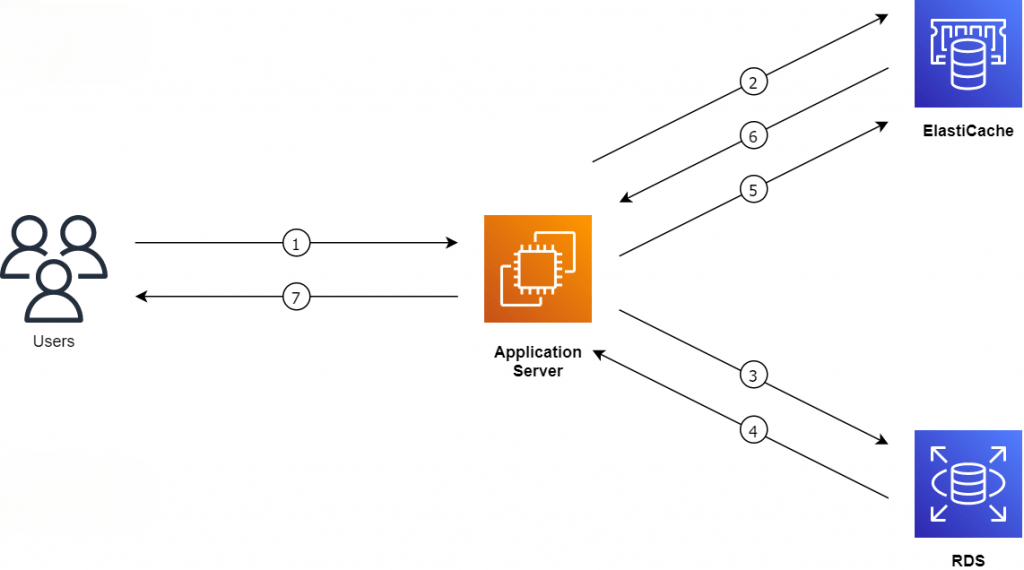
- Introduction: What is AWS ElastiCache?
- Key Features of AWS ElastiCache
- How AWS ElastiCache Works: The Technical Overview
- Benefits of Using AWS ElastiCache for Your Applications
- Supported Caching Engines: Redis and Memcached
- Setting Up AWS ElastiCache: A Simple Guide
- Real-World Use Cases of AWS ElastiCache
- Conclusion
Introduction: What is AWS ElastiCache?
AWS ElastiCache is a fully managed, scalable, and highly available in-memory caching service that Amazon Web Services (AWS) provides. It allows developers to enhance application performance by reducing latency and improving throughput by temporarily storing frequently accessed data in memory. Instead of repeatedly querying a database or other data sources for information, ElastiCache enables fast access to data by caching it in memory. Database access can become a bottleneck when working with data-intensive applications, primarily when the system handles high traffic or requires frequent retrieval of the same data, a challenge addressed in Amazon Web Service Training, where learners explore best practices for optimizing database performance and scaling cloud-based applications efficiently. This is where ElastiCache shines, as it offers an in-memory data store that significantly speeds up retrieval times, leading to a more responsive and efficient application. AWS ElastiCache supports two primary caching engines, Redis and Memcached, each with its use cases and advantages. These engines allow businesses to tailor their caching strategy, whether low-latency key-value data storage or complex data structures, to fit their needs. In this comprehensive guide, we will explore the features, benefits, and configurations of AWS ElastiCache to understand how it can optimize your application’s performance and why it has become a key component of modern cloud-based applications.
Explore AWS in Depth, Check Out Our Comprehensive AWS Course To Gain Insights From Our Experts!
Key Features of AWS ElastiCache
AWS ElastiCache is packed with powerful features designed to make it easier to manage and scale caching infrastructure while optimizing the speed and reliability of your applications. Some of the key features of AWS ElastiCache include:
- Fully Managed Service: AWS ElastiCache handles the most complex tasks in managing an in-memory data store, such as patching, backups, scaling, and maintenance. This reduces teams’ operational overhead, allowing them to focus on developing applications instead of managing infrastructure.
- Automatic Scaling: ElastiCache can automatically scale to handle traffic fluctuations. It supports vertical and horizontal scaling, allowing your cache cluster to scale up or down based on performance requirements. For example, you can easily add or remove nodes to meet growing demands without manual intervention.
- High Availability and Fault Tolerance: AWS ElastiCache provides high availability through multi-AZ (Availability Zone) replication, ensuring your data is continuously available, even if one availability zone goes down, a crucial feature in Cloud Technologies that ensures resilience and fault tolerance in cloud-based systems and applications. Automatic failover ensures that the caching layer remains operational, providing uninterrupted service to your users.
- Backup and Snapshot Support: ElastiCache allows users to create backups of their in-memory data and store snapshots, which can be used to restore the system to a previous state. This is particularly important for mission-critical applications that cannot afford data loss.
- Encryption at Rest and In Transit: AWS ElastiCache supports encryption for data both at rest and in transit. This means that your cached data is securely stored and transmitted, offering peace of mind for businesses concerned with compliance and security.
- Real-Time Monitoring: AWS ElastiCache integrates seamlessly with Amazon CloudWatch, allowing developers to monitor cache performance in real time. You can track key metrics such as cache hit ratio, eviction rate, memory usage, and CPU utilization to optimize performance and maintain healthy cache clusters.
- Integration with AWS Ecosystem: ElastiCache integrates easily with other AWS services like Amazon EC2, Amazon RDS, and AWS Lambda, making it easier to build highly performant and cost-effective cloud applications.

How AWS ElastiCache Works: The Technical Overview
AWS ElastiCache acts as a caching layer between your application and your data store (such as Amazon RDS, DynamoDB, or an on-premises database), temporarily storing frequently requested data in memory. This setup allows rapid access to data without the overhead of querying the underlying database. The main components of ElastiCache include cache nodes, which are instances that store portions of in-memory data, a concept important in DevSecOps, where securing and efficiently managing the infrastructure, including caching mechanisms, is essential for maintaining both performance and security in cloud environments. A cache cluster consists of multiple nodes that distribute the load, ensuring higher throughput and fault tolerance. Cache clusters can be configured to operate in a multi-node or multi-AZ deployment for redundancy and high availability. Additionally, ElastiCache supports replication, particularly with Redis, to maintain data consistency across nodes. In the event of a node failure, the system automatically promotes a replica to become the primary node, ensuring seamless failover. Since memory is limited, ElastiCache offers eviction policies such as Least Recently Used (LRU) and Least Frequently Used (LFU), allowing you to choose the most appropriate policy based on your application’s caching requirements.
Interested in Obtaining Your AWS Certificate? View The AWS Course Offered By ACTE Right Now!
Benefits of Using AWS ElastiCache for Your Applications
In-memory caching solutions like AWS ElastiCache offer multiple benefits to businesses, especially those running high-performance applications with heavy read/write operations. Here are some of the core benefits:
- Faster Data Retrieval: AWS ElastiCache minimizes the need to make repetitive database queries by caching frequently accessed data in memory. This dramatically reduces latency and accelerates response times for your application, leading to a more seamless user experience.
- Reduced Load on Databases: With data being cached in memory, your databases are no longer the primary source for every data request. This can significantly reduce database load, allowing the database to focus on more complex queries while ElastiCache handles the frequently requested, non-dynamic data.
- Improved Application Scalability: AWS ElastiCache’s ability to scale horizontally ensures that your application can handle increasing requests without compromising performance, a critical concept taught in AWS Training, where students learn how to leverage scalable cloud services like ElastiCache to optimize application performance and scalability. By adding more nodes to the cluster, ElastiCache can distribute the cache load more evenly, thus preventing bottlenecks.
- Cost-Effective Performance Optimization: Storing data in memory is faster but could be more expensive if managed on-premises. However, AWS ElastiCache allows you to reduce infrastructure costs while still achieving high performance. This results in reduced operational costs for managing your caching layer.
- Consistency with Multi-AZ Deployments: For applications requiring consistent uptime, AWS ElastiCache offers multi-AZ replication, ensuring that the cache is still available in the event of a failure in one of the availability zones. This high availability feature ensures minimal downtime and disaster recovery capabilities.
- Enhanced Developer Productivity: By providing a fully managed service, AWS ElastiCache simplifies the caching process for developers. You don’t need to spend time managing hardware, installing updates, or handling complex configurations, freeing up resources to focus on other aspects of your application.
Supported Caching Engines: Redis and Memcached
AWS ElastiCache supports two popular caching engines: Redis and Memcached. Each of these engines has its unique features and use cases. Redis offers advanced data structures such as lists, sets, sorted sets, hashes, and bitmaps, making it ideal for various use cases like session storage, real-time analytics, and pub/sub messaging systems. Unlike Memcached, Redis provides data persistence options, allowing data to be saved to disk, which is essential when data durability is required. Redis also supports built-in replication and failover, ensuring that data remains available even if a failure occurs, a crucial feature in protecting against Cyber Extortion, where maintaining data availability and redundancy is vital to prevent data loss or unauthorized access during security breaches. Additionally, Redis enables atomic operations on complex data types, which is particularly useful for applications involving counters, queues, and leaderboards, allowing for efficient and reliable data manipulation. Memcached is a simpler, faster, and more scalable caching engine compared to Redis. It stores data in key-value pairs and is highly efficient, making it ideal for use cases where only simple data needs to be cached and advanced features are not necessary. Memcached uses a multi-threaded architecture to handle concurrent requests efficiently, which is particularly beneficial when scaling across multiple cores.

However, it is an ephemeral cache, meaning that cached data is lost when the node is restarted, making it suitable for applications that do not require persistent data storage. Choosing between Redis and Memcached depends on your specific use case. If you need advanced features like persistence, complex data types, and high availability, Redis is the preferred choice. If your caching needs are more straightforward and you’re looking for speed with a simple data structure, Memcached may be more appropriate.
Looking to Master AWS? Discover the AWS Masters Course Available at ACTE Now!
Setting Up AWS ElastiCache: A Simple Guide
Setting up AWS ElastiCache is straightforward. Follow these basic steps to get started:
- Log into AWS Management Console: Begin by logging into your AWS account and navigating to the ElastiCache service in the AWS Management Console.
- Choose Cache Engine: Select whether you want to use Redis or Memcached as your caching engine, similar to how Docker Swarm allows you to choose between different orchestrators to manage containerized applications effectively, ensuring optimal performance and scalability in distributed systems.
- Create a Cache Cluster: Configure the cache cluster by selecting the number of nodes and their instance types. You can also choose to deploy your cluster across multiple availability zones for high availability.
- Configure Security and Access: Set up your VPC (Virtual Private Cloud) and security groups to control access to your ElastiCache cluster. This ensures that only authorized applications can interact with the cache.
- Connect Your Application: After the cluster is set up, connect your application to the ElastiCache endpoint to begin caching data.
- Monitor and Scale: Use CloudWatch and ElastiCache metrics to monitor cache performance. Based on your usage, you can scale your cluster vertically (by increasing the node size) or horizontally (by adding more nodes).
Real-World Use Cases of AWS ElastiCache
AWS ElastiCache has a wide range of real-world applications in various industries. Some examples of how businesses leverage ElastiCache include:
- E-commerce:To guarantee quick client access, e-commerce websites employ ElastiCache to store session data, product catalogs, and price details, similar to how AWS State Machine helps manage and automate workflows, ensuring efficient processing and quick access to critical data in serverless applications. This lowers latency during high traffic, such as Black Friday sales.
- Gaming: Online gaming platforms use ElastiCache to store session data, leaderboards, and game states in real time, giving users a smooth experience.
- Social media: To manage heavy traffic and guarantee real-time participation with negligible latency, companies employ ElastiCache to cache user feeds, likes, and comments.
- Financial Services: To guarantee that data is constantly accessible and can be promptly provided to end users, financial institutions employ ElastiCache to cache market data, stock prices, and transaction histories.
Go Through These AWS Interview Questions & Answer to Excel in Your Upcoming Interview.
Conclusion
AWS ElastiCache is an essential tool for businesses and developers seeking to optimize the performance of their applications through in-memory caching. Whether you want to scale your application, reduce database load, or speed up user interactions, ElastiCache provides a powerful solution with flexible caching options, high availability, and robust security features. By choosing between Redis and Memcached, businesses can select the right caching engine based on their specific requirements, ensuring optimal performance, reduced latency, and improved user experience, a key decision point explored in AWS Training, where learners gain the skills to choose and implement the best caching solutions for their cloud-based applications. Moreover, with its fully managed nature, AWS ElastiCache makes deploying, monitoring, and scaling a caching layer easier than ever without managing infrastructure. For any organization looking to improve application speed, responsiveness, and scalability, AWS ElastiCache is a critical service that can help you achieve those goals with ease and efficiency.





